Introduction
Updated 2/26/14 – Returned product
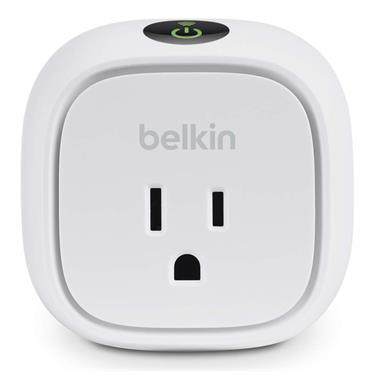
| At a Glance | |
|---|---|
| Product | Belkin WeMo Insight Switch (Model F7C029fc) |
| Summary | Wi-Fi enabled switch that can control appliances up to 1800 Watts and monitor power usage |
| Pros | • Design doesn’t block the second AC outlet in a duplex • Switches loads up to 1800 W • Support for Android and iOS mobile platforms • Integrates with IFTT (If This Then That) • Button on top of unit can turn on/off load without using a mobile device • Scheduled events • Estimates power usage |
| Cons | • Android Application poorly designed and barely functions • Events created on Android platform don’t trigger the device. • Events created one one device don’t sync to other configured devices • No dimming capabilities • No Windows or MacOS desktop applications • Not Wi-Fi Certified • Poor documentation |
Belkin’s line of WeMo home automation products has been around for quite some time. In November of last year, Belkin announced the availability of their latest addition to the WeMo line, the WeMo Insight Switch. The $59.99 Insight switch is similar to the original $49.95 WeMo switch, but comes in a new, more compact form factor and includes the ability to monitor power usage. Other features include the ability to schedule on/off events and to integrate the device with IFTT (If This Then That) “recipes”.
I wasn’t really looking to buy a home automation product, but on a recent visit to Staples to pick up some printer paper, I was attracted to the WeMo “end cap display”. I thought it would be interesting to play with, and for a device like this, I can always find a use for it around the home. My initial setup experience was not the most positive, so I relayed my experience to Tim. He suggested that I dig in a little deeper and write a short review of the product.
The WeMo Insight switch is a very simple device. It plugs into a standard three-pronged outlet. The plug is offset so that you can plug it into the top outlet of a standard duplex plug and still use the lower outlet.
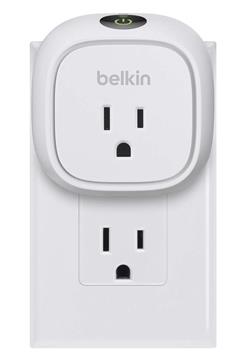
The Belkin WeMo Insight doesn’t block the bottom plug
On the top of the device, there’s a small button with backlit indicator lights. There’s an On/Off indicator as well as a Wi-Fi indicator that flashes during setup. On the back is a label that shows the default name of your WeMo device. Take note of the default name – you’ll need the name for the setup process. The name defaults to WeMo.Insight.XXX where XXX is the last three digits of the device’s MAC address.
Setup
The included Quick Install Guide is the only documentation that you receive with the product. There is no user guide and the only documentation that you’ll find is a series of FAQs in the support section of Belkin’s web site. The setup is a four step process, but I think that Belkin was a little too sparse with verbiage on the quick start guide.
- Step 1: Plug in the Insight Switch
- Step 2: Download and install the latest WeMo App.
The icon shown on the QIG was an old icon and didn’t represent the latest version. Initially, the Apple App store didn’t find WeMo when I searched for it with my iPad. They should have instructed you to search for iPhone apps. The iOS version is just an iPhone App – there isn’t an iPad version of the app, so you have to turn your iPad sideways to use it. - Step 3: In settings, select Wi-Fi. Connect to the WeMo network.
It would have been helpful for some additional instruction to help identify the WeMo network. - Step 4: Launch the WeMo App to complete the setup.
I own several Android devices including a Nexus 7 and a Motorola Razr Max. I checked the compatibility list below and decided to initially install the application onto the Nexus 7. I also planned to install the iOS app on my iPad to see how the two apps compared.
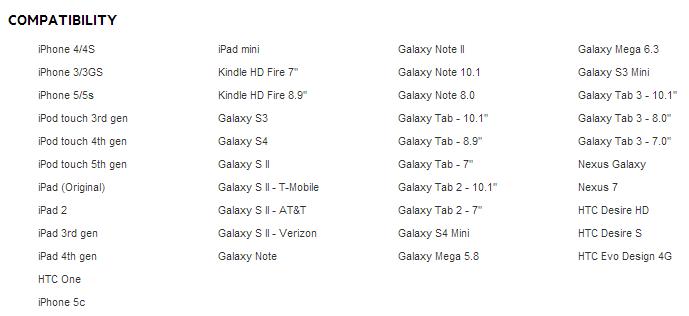
Belkin WeMo Insight Compatibility list
I plugged in the device and successfully attached my Nexus 7 to Wemo.Insight.2FB. The network showed up as an open network. Once attached, I launched the WeMo Android app. The app found the device and started scanning for available Wi-Fi networks. I selected my Wi-Fi network from the list and it prompted me for the network key. I typed in my network key and it said that the key was incorrect. I typed it in again and it appeared to attach.
Once you have identified your home network and configured the WeMo, it no longer broadcasts its default name, as it is now in client mode on your network. I reassociated my Nexus with my home network, but initially, the WeMo application couldn’t find the device. After resetting the WeMo device and re-installing the WeMo software, the software finally “found” the WeMo on the network.
Next, I decided to install WeMo on my iPad. I launched the application and it initially scanned the network for a WeMo device. It couldn’t find it. Instead, the application presented me with a brief slide show demonstrating how to set up a new device. Note that there aren’t any instructions for how to install and configure additional devices to control your WeMo. If things work the way they are supposed to work, you just install the app on another device, and the new device should just find the WeMo if you are on the same local network as the WeMo.
By this time, I was getting somewhat frustrated with the whole installation experience. Though I was not experiencing any wireless connectivity issues with any of the four mobile devices or my HDTV, I decided to reboot my router. I uninstalled the software from all three devices (by now, I had also tried to install the WeMo software on my Motorola Razr Max) and tried a fresh installation. The router reboot seemed to solve the “device not found” issues, and I was able to successfully install the software on all three devices.
The WeMo Insight switch (as well as other WeMo devices) can be controlled remotely. Part of the setup routine establishes remote connectivity. The process is completely automatic – you don’t have t configure any settings such as DDNS, set up port forwarding, etc. To Belkin’s credit, the remote setup worked, and I was able to remotely control the Insight switch from either cellular or from Wi-Fi networks other than my own on both platforms.
Hands On
Once I got the software installed and working on all three devices, I started to create some rules to turn the device on and off at specific times. The WeMo application for Android devices is designed to look very similar to the iPhone WeMo app. The composite image below shows the landing page for iOS (left) and Android (right). In this image, the device is shown in the “Off” state on the iPad and is in “Standby” mode in the Android version. The yellow dot next to the power button on the right indicates Standby. If the indicator was green, the device would be in the On mode.
The landing screen shows configured WeMo devices – you can have up to 16 according to Belkin. The power switch on the right lets you toggle the device on or off from within the software. If you click on the green down arrow adjacent to the Insight icon, a drop down screen shows details on power consumption.
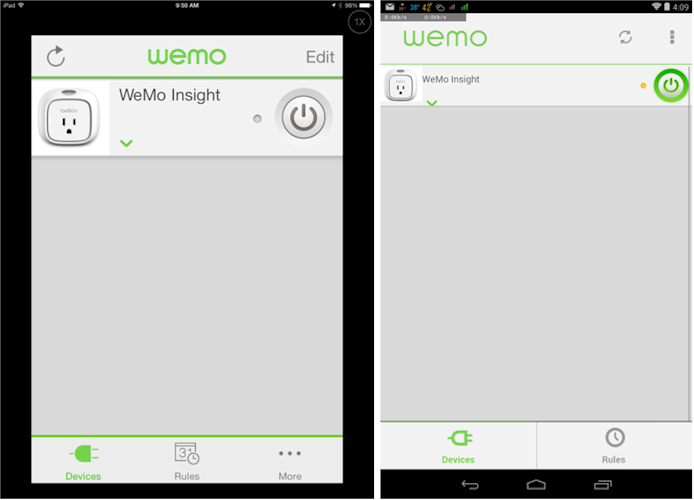
Insight Landing Page for the iOS (left) and Android (right) WeMo App
Across the bottom of the screen, you can select the Devices screen, the Rules screen, and on the iOS version “More”. On the Android version, you need to click on the “three dot” menu icon located above the power switch to access additional features.
You use the Rules screen to create rules to turn the device on or off, or set a range that allows you to specify both on and off time in a single rule. Your time choices also include Sunrise or Sunset.
I created rules on both the Nexus 7 as well as on the iPad. Rule setup, shown in the gallery below, is similar on both platforms. I believe that the rules are supposed to synchronize between devices controlling the same WeMo device, but in my testing rules created on Android did not sync with the iPad and vice-versa.
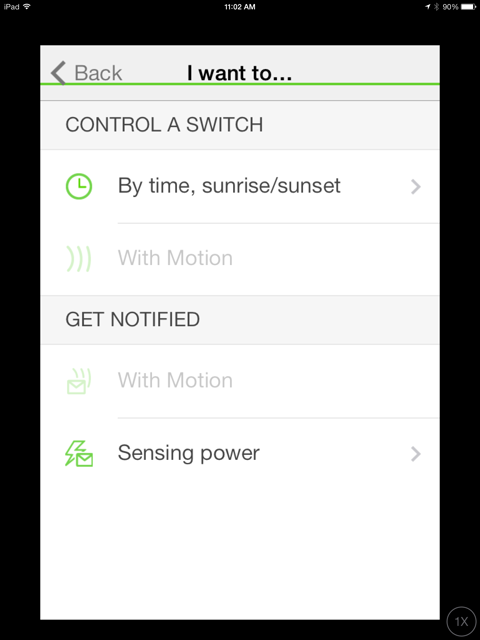
This opens up choices by Time or with motion. My unit didn’t have the optional motion detector, so it’s grayed out.
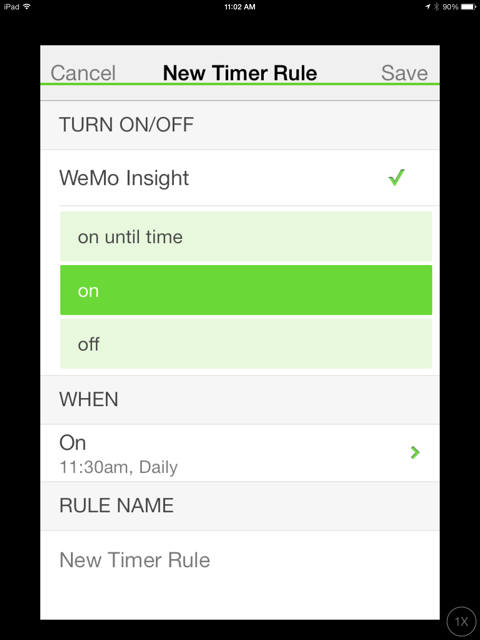
Choose the action On, Off or On Until time
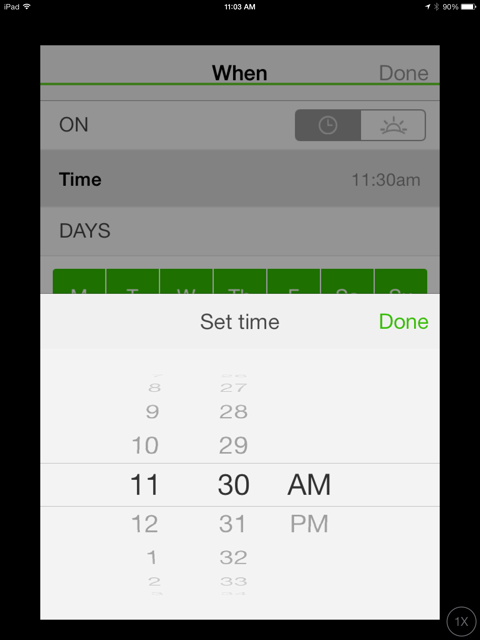
Set hours, minutes and AM or PM
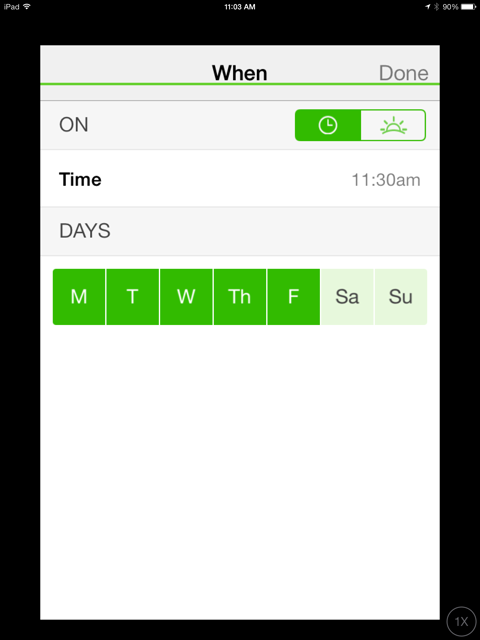
Select the days of the week for the rule to execute
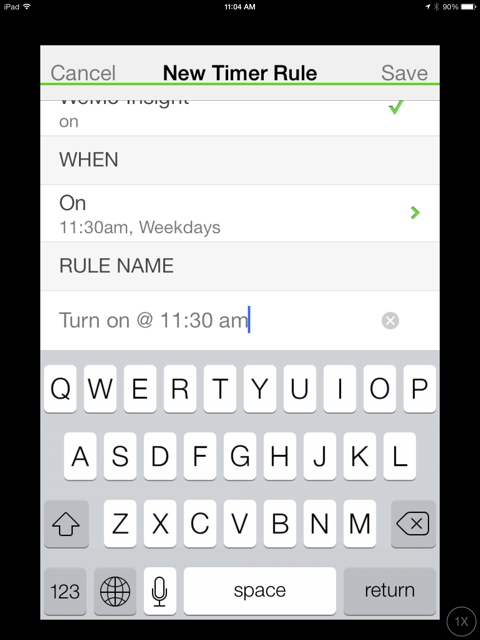
Create a rule that’s descriptive of the action and click Save
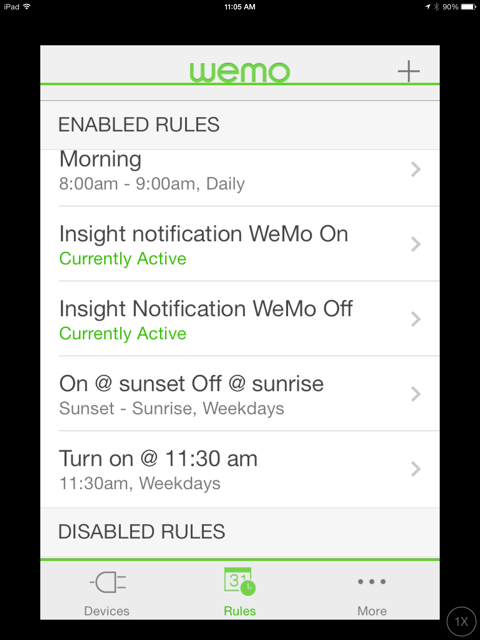
Your new rule will appear in the Enabled Rules. Optionally, you can disable any rule to prevent execution.
The gallery below shows other configuration options.

This opens up choices by Time or with motion. My unit didn’t have the optional motion detector, so it’s grayed out.

Choose the action On, Off or On Until time

Set hours, minutes and AM or PM

Select the days of the week for the rule to execute

Create a rule that’s descriptive of the action and click Save

Your new rule will appear in the Enabled Rules. Optionally, you can disable any rule to prevent execution.
Tracking Power Consumption
Most likely, there are two reasons you bought the WeMo Insight. First, you may want to measure power consumption and estimate how much a device is costing you for power. The WeMo Insight tracks “On” time and power flowing through the device. A configurable option allows you to set both the currency and the rate that the device uses to make its estimates.
By default, the currency is US$, and it defaults to US $0.111/kWh. It tracks both daily “On” time, and updates the average daily “on” time. One of the options allows you to export and email the actual usage for the previous 45 days. You can also automatically export the data daily, weekly or monthly. The file is formatted in CSV format which you can import directly into Excel.
The Insight goes into standby mode if the current drawn by device plugged in drops below the configured threshold. In standby mode, the load power socket is still energized and the device shows as being on. However, the device will stop aggregating “on time” for the day, and time spent in standby won’t be calculated into estimated energy cost.
The Insight might drop into standby mode if, for example, you had a TV plugged into it and you turned it off. The switch would still provide power, but if the power consumption of the TV dropped below the standby threshold (default is 8 W), it would go into standby.
I discovered standby mode because initially I had plugged in a desk lamp with an LED light bulb. The bulb, according to Insight, draws only 7 watts – not enough to ever cause the device to come into the “on” mode. I lowered the threshold to 3 W using the device Edit page so that the Insight would aggregate power usage and would show its status “on” rather than standby. In the image below, the device has been on for 4 minutes, but has been in standby since 12:36 – about a minute if you compare it to the iPad’s time at the top of the screen.
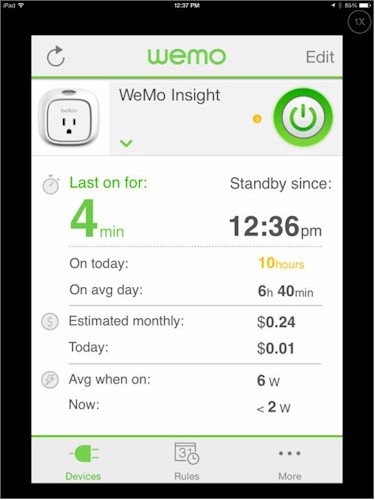
Belkin WeMo Insight Standby
IFTTT
The second and perhaps more important reason for purchasing a WeMO switch is that you want to turn devices on or off using schedules that you define. We’ve already seen the built-in method of setting up these rules. But WeMo products also support IFTTT (If This Then That). IFTTT allows you to set up simple rules or “recipes” as they are called on IFTTT’s web site. A recipe determines the action taken when a specific trigger occurs.
To use IFTTT, you need to create an account. Don’t worry, it’s free. From within the main “More” menu, there’s an option to “Connect to IFTTT”. When you click on that menu, you generate a registration key that’s valid for only 30 minutes. Within 30 minutes, you can register your WeMo device with IFTTT. Thereafter, your WeMo device is connected to IFTTT.
I created several different rules that would send an email to me if my Insight either turned on or off. The rules worked, and I received email almost instantly that confirmed the change of state.
The image below shows the different triggers that can be used in conjunction with your Insight. For each recipe, you could send an email or post to Facebook (I’m not sure why you’d do that) when the trigger condition is met.
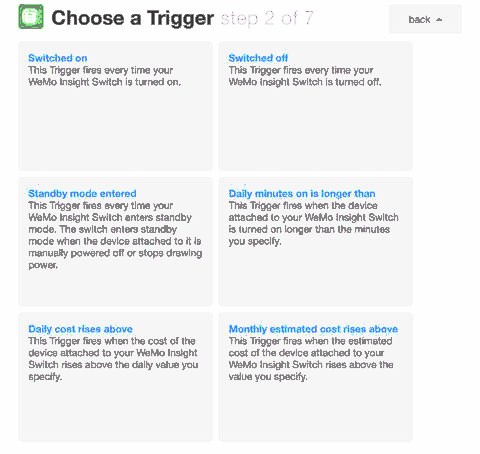
IFTTT Trigger conditions for WeMo Insight
Closing Thoughts
After a frustrating setup experience, I was ready to return the WeMo Insight to Staples. After uninstalling the apps from all platforms, rebooting my router and reinstalling the apps, the setup experience was better. Though my Nexus 7 didn’t notify me of a firmware upgrade, the iPad app did. I upgraded the firmware, which seemed to improve things a bit. When it comes down to the final analysis, reviewing the WeMo Insight was like reviewing two products: An Android Product and an iOS product.
On the plus side, the iOS application seems much more mature and operated much more smoothly. Connections to the device, once configured, were fairly quick, and updating the rules happened fairly quickly, as well. Scheduled rules for on times, off times or intervals all executed as expected, and the state of the switch reported on the iPad matched the actual switch state, i.e. if the iPad reported the switch was on, the light was illuminated.
That’s not to say that there’s not room for improvement on the iOS app:
- Though I only tried out a sunrise/sunset rule for one day, that schedule didn’t execute – at least not when I expected it to execute. I guess I’d have to try it again and wait a full 24 hours to see if/when the rule executes.
- Schedules don’t synchronize with the schedules created on Android device.
- It would be nice if the power meter gave you a running total of kWh usage by day and month to date. For tracking power, I’m more accustomed to the much more robust reporting of my Kill-o-Watt EZ meter.
- An app designed for the iPad would be nice.
The Android application is a completely different story. I had numerous problems with the application. The most serious problem was that none of the rules that I created on either of my Android devices executed and performed the on or off action expected. Rules didn’t synchronize with my other Android device or the iPad. About the only thing in the app that worked was the power button, which you could use to manually control the Insight and the power monitoring.
I thought that I was alone, but when I looked at the comments and ratings for the WeMo Insight on the Google Play store two words come to mind: Flamefest. Here’s a small sample of the comments:
“This feels like a beta experience from a small startup company on Kickstarter, not an app from a large and established company!”
“Great idea, poor execution. Doesn’t get better with updates”
“Poor development. The programming for the Android app is pure crap.”
“App developed by a 2 year old. This app/hardware combo is the biggest piece of crap I’ve ever come across and Belkin should be embarrassed. Much of the UI is quite unintuitive”
“Still hangs a lot. App is nearly non functional”
“DO NOT BUY. WeMo is garbage. The rules do not work.”
For me, the jury is still out. I still have a couple of weeks left within the Staples return policy. The WeMo Insight works fairly well on my iPad, although since I have a cover with a Bluetooth Keyboard, I find it annoying to have to turn the iPad on its side to use it. But the rules I created work, and the IFTTT notifications arrive promptly in my email. That may be enough to convince me to keep it.
On the other hand, if I had only Android devices, I’d be returning it without hesitation. At some point in time, Belkin may get the Android app to work as well as the iOS app. But for now, you could probably find better things to do with your $60.
Important! Shortly after posting, we came across this Ars article describing security vulnerabilities that were patched in January, in version 3949 of of the WeMo firmware. So be sure you update your firmware!
2/26/14 Postscript: I returned the product. It started exhibiting erratic behavior and was starting to turn itself off/on rapidly at random times. IFTTT in one afternoon sent about 400 trigger messages. When the light started flashing when I was in the room, that sealed the WeMo Insight’s fate.
